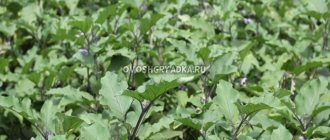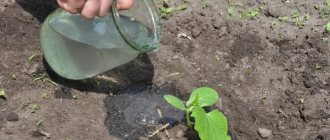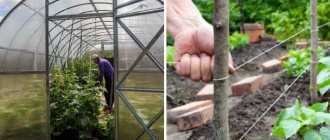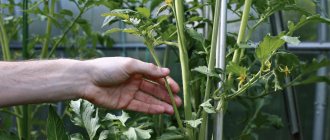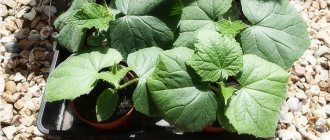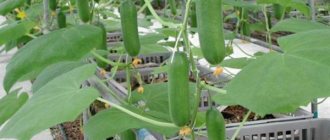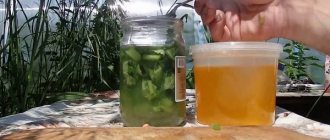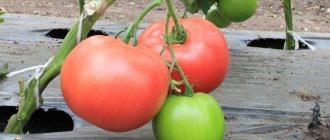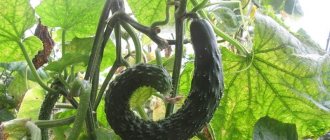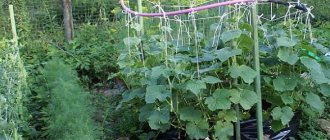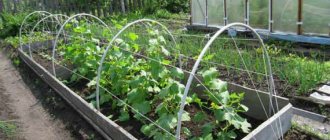The need for the formation of cucumbers and the advantages of the procedure
Formation is done by pinching off excess branches from the shoots. This is not necessary if the cucumbers grow in open ground and there is a sufficiently large distance between them.
Reasons for formation:
- If the growth is not kept under control, the roots will not be able to cope with such a load. As a result, some shoots will not receive enough moisture and necessary substances, and the fruits will be of poor quality.
- Too dense bushes will not allow insects to pollinate the plants efficiently.
- If shoots grow too close together and form thickets, diseases can spread quickly. It is enough for one bush to get sick, and soon everyone will be affected.
- Formed shoots are easier to care for and more convenient to weed and water.
Most often, cucumbers are tied up. It is necessary to place a support near each bush in order to place the stem on it. A shoot lying on the ground may rot.
Advantages of formation:
- The load on the root system begins to be distributed evenly.
- All leaves and fruits receive enough light and moisture.
- Caring for bushes becomes much easier.
- It is convenient to detect diseases in time and carry out their prevention.
- Productivity increases significantly.
- Convenient to collect ripe fruits.
If you ignore this procedure, the following problems may occur:
- Deficiency of nutrients, which leads to the death of ovaries.
- Irregular shape of preserved fruits and their immaturity.
- Reducing the amount of harvest.
- Increased likelihood of disease spread.
Prevention of diseases and pests
The greenhouse usually creates favorable conditions for the rapid development of pests and the spread of diseases. This is facilitated by high air temperature and humidity. To reduce the likelihood of infection, it is necessary to follow the rules of agricultural technology and take into account crop rotation when planting. Frequent ventilation will protect you from high air humidity and heat. It is important to avoid drafts so that the plants do not get sick from a sharp drop in temperature.
The main pests of cucumbers in greenhouses are:
May be interesting Description and characteristics of the cucumber variety Claudia f1: planting and care Why are cucumbers soft or prickly in the greenhouse and in the garden? Feeding cucumbers using the foliar method: features and rules for applying fertilizers
- The whitefly is a small flying insect that feeds on plant sap. It leaves behind a sticky discharge on the leaves, causing sooty fungus to appear. The appearance of whiteflies can be prevented by timely weeding, removal of affected leaves and glue traps.
- The melon aphid spreads in greenhouses in the second half of summer. It quickly attacks the plant and destroys it completely within a few days. You can fight this pest by treating the bushes with pepper or tobacco infusion.
In addition to insects, diseases cause great harm to plants. Cucumbers are characterized by root rot, verdigris, and powdery mildew. Affected plants become covered with spots, plaque, and the root system begins to rot. The bushes stop developing, turn yellow, and do not bear fruit. If signs of infection are detected, it is necessary to immediately get rid of such plants in order to prevent the spread of the disease to neighboring specimens.
Requirements for materials and tools
In order to make a good support, you need to prepare:
- Wooden blocks about 2 m long.
- Copper wire, jute twine.
- Strips cut from long waste rags.
- Wooden slats.
The main stem is tied with soft twine so that it is not damaged during further growth. Under no circumstances should wire or thin thread be used for this purpose, as they will cut the stem.
Required tools:
- Scissors.
- Pliers, hammer, nails.
- A small sledgehammer that will be convenient for driving pegs into the soil.
What to consider when shaping cucumbers
Procedures vary depending on whether the gardener is growing a specific variety or a first-generation hybrid. Hybrids (marked F1 on the bags) may have their own growth characteristics, so the method of formation will be different.
Main differences:
- On varietal bushes and those hybrids that have long been bred, female flowers appear on the side branches, and barren flowers (male flowers) grow on the main stem. Therefore, it is most important to start forming the side lashes first.
- Newly bred hybrids most often produce a female type of flowering. Ovaries appear both on the main stem and on the side shoots. In this case, one stem is usually formed, which receives maximum light.
What varieties of cucumbers can be grown with one stem?
Before planting cucumbers in your garden, you should know about the growing characteristics of different varieties. First generation hybrids are marked F1 on packets of seeds. They can be grown in a greenhouse or in open beds, but seed material for propagation cannot be obtained. To do this, you need a varietal cucumber, the characteristics of which will be preserved.
Some varieties are pollinated by bees, others are capable of self-pollination and do not require the presence of insects, and there are also parthenocarpic-type crops that do without pollination. The formation of a single stem is most often used for hybrids that are grown in greenhouse conditions.
Important!
The ideal time for the operation is two weeks after planting the seedlings.
Properly formed cucumber bushes have several advantages compared to those that have not been subjected to such treatment:
- increasing productivity;
- saving space in the greenhouse;
- higher quality vegetables;
- making it easier to care for garden beds;
- resistance to common diseases and pests;
- lack of barren flowers on the bushes;
- Plants bear fruit longer;
For the sake of such results, it is worth trying and spending some time. In order not to harm the plantings through your actions, before starting work, it is recommended to carefully study the algorithm of the procedure and the issues of caring for cucumbers after it.
Methods for forming cucumbers
There are two options - one or several stems. Here are step-by-step instructions for both:
Forming cucumbers into one stem
This method is ideal for growing cucumbers in greenhouses.
- A support must be installed near each bush.
- After 5-6 leaves appear, the shoot is tied to the crossbar.
- When shoots appear, they must be pinched until the main stem reaches a length of 50 cm. Thus, the necessary substances will be directed to the formation of ovaries.
- After the main stem reaches 0.5 m, you need to leave two greens at every third leaf. In the upper part of the stem it is necessary to leave three ovaries near every fourth leaf.
Forming cucumbers into several stems
This method makes it possible to obtain rapid growth of cucumbers, so you need to pay attention to thinning the leaves. As a rule, cucumbers that are pollinated by insects are formed this way.
- The main stem is tied to a trellis (mesh) with soft twine.
- The top of the shoot is pinched.
- The side shoots are also tied to the trellis, positioned at an angle of 60 degrees to the main stem.
- The tendrils appearing on the side stems wrap around the main one. This will make it stronger.
Reviews
Ivan, Saratov region
Last year, for the first time, I tried to grow cucumbers in a greenhouse and formed them into one stem. The result was impressive. Caring for plants has become much easier, and productivity has increased. There were much fewer diseases.
Artem, Tver
We constantly tear off the leaves at the bottom of the cucumbers. This reduces the likelihood of diseases and there are fewer pests. Plants bear fruit more actively after this treatment.
For cucumbers growing in greenhouse conditions, formation is mandatory. The procedure helps active development and stimulates fruiting. Although it takes a long time to form, subsequent plant care is simplified.
Formation of parthenocarpic varieties of cucumbers
Such hybrids grow well and produce many branches. Before planting seedlings, you need to prepare a trellis and attach pieces of twine to it. The stem wraps around a support, which is attached under the leaf.
We analyze in detail the features of the formation of such varieties:
- A blinding zone is formed on the stem. It is located at a distance from the first to the fourth node. There all stepsons, mustaches and ovaries are removed. Then, as the bush grows, the leaves in this zone, which will turn yellow, are also torn off.
- The next tier is from sheets 5 to 7. The stepsons and whiskers are removed, but the ovaries remain. They are the ones who will bear the first fruits.
- The third tier is from 8 to 10 sheets. Here only the mustache is removed. The stepsons are grown and pinched so that they have one leaf and one green leaf.
- The fourth tier is 11-13 sheets. It is formed similarly to the third, but two leaves and ovaries are left on the stepsons.
- Fifth tier - 14-16 sheets. Here the technique is the same as in the previous two, but three leaves and greens are preserved on the stepsons.
- The top of the bush up to the trellis is decorated in the same way, but 4 leaves and ovaries are left on the side branches.
- When the vine becomes higher than the trellis, it must be thrown over and the growth directed downwards. After the lash grows 60 cm, the growth point must be pinched. This measure stimulates the growth of lateral branches, one of which will become a continuation of the main stem. It is also pinched after it grows 50 cm.
Features of the formation of bee-pollinated cucumber varieties
When growing cucumbers in a polycarbonate greenhouse and other types of bee-pollinated cucumbers, special attention must be paid to the formation of the bush.
The peculiarity of such varieties is that there are male flowers on the main stem, which means that the formation of several lashes is required.
- The central lash is pinched over the 5th leaf and carefully tied with soft twine.
- As they grow, the side lashes are tied side by side, maintaining an angle of 60° to the main stem.
- During the growth of side lashes, it is important to promptly remove mustaches and stepsons.
- All lashes that have grown to a horizontal trellis must be wrapped around it as they grow and then pinched.
But another formation is also possible, as shown in the diagram and described in the video:
Formation of bouquet type cucumbers
Bundle cucumbers (bearing fruit in bunches) are formed in a special way. The leaf axils usually have many ovaries - from 3 to 12, which provide an excellent harvest. Therefore, there is no need to form side lashes.
Formation scheme:
- All tendrils, shoots and flowers are removed from a newly planted plant. They should not be up to 4 nodes. This technique is necessary to provide the bush with nutrients for rapid growth.
- Along the entire remaining length of the stem to the trellis, the tendrils and stepsons are removed.
- When the lash grows to the trellis, it is thrown over and allowed to grow downwards. At a distance of about 25 cm from the soil, pinch out the growing point.
As you can see in the photo, with this method of forming cucumbers, the entire harvest of greens will be obtained from the main stem.
Parthenocarpic bouquet varieties have an important advantage - a large amount of yield and easy shoot formation.
Formation schemes
In practice, three schemes for forming a cucumber bush have taken root. If you are planting several varieties with different types of branching, you need to form the bushes according to a scheme suitable for each variety:
- in a classic way;
- in one stem;
- using the Danish Umbrella method.
We form a bush according to the classical scheme
This is a universal approach, very popular among summer residents who grow cucumbers. A bush formed according to this pattern resembles an inverted Christmas tree.
As the central conductor grows, step-by-step removal of stepsons, ovaries and flowers must be carried out. From the beginning of the stem to the 5th leaf, remove everything from the axils. Count out the next 5 leaves, leave the stepsons in them, but pinch them after the first leaf.
Leave 2 leaves on the branches emerging from the next 3 axils, 3 from the 3 nodes above. Throw the central stem, which continues to grow, over the top of the trellis and point it down. At a height of 60 cm from the ground, the crown can be pinched.
Bush with 1 stem
Growing a cucumber with a bunch (super bunch) type of fruiting in greenhouses will be beneficial for the summer resident. In bunched cucumbers, the formation of ovaries (4 – 7) occurs in the nodes of the central conductor. This results in a very powerful load on the conductor, so the single-stem method of maintaining a cucumber is considered optimal.
We pluck out the ovaries, stepsons and flowers from the first 4 axils. We leave the ovaries in subsequent nodes, and pluck out the stepsons one by one along the entire length of the central stem.
By choosing a weakly branching bunch hybrid for your greenhouse, you can significantly save time on pinching bushes. The advantage of forming 1 stem is a large yield obtained per square meter. This is achieved by planting seedlings more densely.
Experienced summer residents manage to collect 15 kg of bunch-type cucumbers per unit area in their greenhouse. Naturally, only those who choose the correct molding scheme and do not forget about fertilizing and watering.
Danish Umbrella Scheme
This formation of cucumbers in a greenhouse will seem difficult for a beginner. It is used for parthenocarpic varieties for indoor soil grown on a trellis. The liana is divided into 3 zones:
- Zone I - from 0 to 5 knots;
- Zone II - from 5 knots to 9;
- Zone III - all nodes above 9.
See also
Description of the Borisych cucumber variety, its characteristics and yieldRead
In zone I we blind each node. In zone II, you need to leave 1 ovary in each node, and pluck out the stepsons; zone III is the most difficult:
- Leave 2 ovaries in the 7 axils.
- From the fourteenth node we send out a shoot, which we pinch after the 2nd leaf.
- We blind three nodes, and let two shoot along a short path.
- The 20th node is used to obtain a continuation shoot, pinched after the 8th leaf.
- The central lash, which has grown to the top of the trellis, is thrown over it and after 3 leaves the crown is pinched off.
- From continuation shoots, it is permissible to produce 3 shoots of the 2nd order.
Farmers use this scheme in the spring in heated greenhouses. Long-fruited varieties are grown for sale. The seemingly complex scheme for the formation of cucumbers in a greenhouse makes it easier to care for the plantings. The lower part of the greenhouse is free, and all the green mass is at the top, it is well lit, and the bottom is ventilated.
Pinching the old way
Summer residents pinch out varieties planted in greenhouses in the old way. Count 7 nodes from the bottom of the bush and pinch off the crown. Side shoots grow from the axils. All of them are not needed, the three most powerful ones are enough, the rest should be removed. When the side shoots form 4 nodes, their growing point needs to be pinched.
Pinching, pruning, pinching: description, differences and rules of conduct
To properly understand agricultural technology, you must understand the meaning of certain terms:
- Pinching is the removal of the growing point of the main stem or side vine (at the end of the shoot).
- Pruning - removing the stepson or part of the stem, leaves, barren flowers, excess ovaries and tendrils.
- Stepchildren are the rudiments of lateral shoots that grow from the axils of the leaves.
- Stepchildren - removal of stepchildren.
The stems have to be removed for one simple reason - if this is not done, the entire plant will not receive the necessary nutrition, since the root system cannot cope.
To get a good harvest from the side shoots, they must receive the same amount of nutrition as the main stem. This is important for the formation of flowers, ovaries and fruits.
To work, you will need sharp instruments that have previously been disinfected. This is necessary in order not to introduce infection into the damaged stem.
Trimming
Stepsoning
Topping
We recommend the article: why cucumbers dry out, curl, turn yellow and what to do. By the way, if you notice curling of the cucumber leaves, most likely you are not watering the plantings correctly. Please note that before flowering begins, 1 sq. m pour 4-5 liters of water. During the formation of ovaries and fruiting - 10 liters. The water should be warm.
Proper care after formation
For cucumbers to grow well and actively bear fruit, it is not enough to simply plant them in the ground. Plants need proper care. Work in the greenhouse begins long before transplanting seedlings or sowing seeds and does not end after the final formation of the bush.
Cucumber bushes are constantly developing, new shoots and leaves appear on them, and the old ones gradually turn yellow, dry out and die. Parts of the bush that begin to age are periodically removed so that the plant does not waste energy on maintaining them. Shoots and leaves are plucked off in the morning, then during the day the open wounds will dry out and the risk of developing an infection will decrease.
Removing dried and diseased leaves is useful for improving the plant's exposure to sunlight. Additionally, fruit-bearing branches are cut off. By this time they turn yellow and dry out, becoming sources of infection.
Important!
If the time to perform pinching is lost, and the shoots have managed to grow strongly, there is no need to remove them. The loss of a significant part causes stress in the plant and often causes death.
How does the formation of cucumbers help in the fight against pests and diseases?
The appearance of pests can significantly reduce the yield and even lead to its death. Most harmful insects live in the soil and easily move to shoots lying on the ground. Let's look at the pests that are most often found on cucumbers.
Ants
They negatively affect not only the harvest, but also the plant itself. They live in the soil and interfere with normal root growth. In addition, ants carry aphids and can live on the lower vines of cucumbers.
A good means of control is boric acid, to which sugar is added as bait. The mixture should be scattered along the beds. Also, if you sprinkle ash around the cucumbers, it will not only be a good feed, but will also help repel ants. Industrially produced drugs such as Muraviin and Grom show good results. As a preventative measure, you can plant fragrant plants - mint or garlic - between the cucumbers. Their pungent smells repel ants.
Medvedka
The insect reaches a length of 7 cm and lives in the ground. Its main food is plant roots, as a result of which the shoots wither and die.
To combat the pest, you can dissolve laundry soap and washing powder in water. Pour this mixture between the plants. The mole cricket will come to the surface and can be collected and destroyed. Ready-made medications include Medvedox, Grom and Aktara. To prevent its appearance, you can plant cilantro; the insect does not like this plant.
melon aphid
These are small insects, no longer than 2-3 mm. The juices of the plant are used for food. Their secretions are poisonous. Most often, the pest attacks cucumber vines at the end of summer and the root part of the plant is primarily affected. If plants are tied up, aphids are easier to spot and easier to control.
For prevention, it is necessary to check the soil for the presence of anthills and destroy them. After harvesting, the soil must be disinfected by watering with infusion of copper sulfate.
If aphids have already appeared, proven folk remedies will help - an infusion of garlic or hot pepper, a decoction of celandine. Another option is the drugs Actofit, Iskra.
Slugs
These pests love waterlogged soil. It is worth taking a closer look at the beds in rainy weather and avoiding excessive watering. Slugs are especially active at night; they use young leaves for food. This has a bad effect on the shoots, weakening them.
To repel pests, you can use potash fertilizer. The drugs Etisso, Slug Eater, and Groza will also help.
Advice. Prevention is no less important. In the fall, you need to collect all the tops and burn them. It is necessary to remove weeds in a timely manner and periodically disinfect the soil with a solution of potassium permanganate.
Prevention
Prevention of vegetable diseases begins even before sowing. The seeds are soaked for some time in a solution of potassium permanganate. Industrially produced fungicides can be used for this purpose. The soil also needs special preparation to get rid of fungal spores or pest larvae contained in it.
It is useful to sometimes spray growing seedlings with nettle infusion. Regular inspection of the bushes will help you notice in time the first signs of the presence of diseases or parasites on them. You need to remove ripe greens every other day, then the plant will have enough resources for the appearance of new ovaries.
Varieties of cucumbers that do not require formation
Varieties of cucumbers have been developed that do not require shaping. Our portal https://mrdachnik.com recommends.
Artel F1
Parthenocarpic variety, suitable for both greenhouse and outdoor cultivation. It has a determinate bush structure, in which one main stem develops; there are practically no side shoots, so there is no need to pinch them. Flowers are formed exclusively from females, which increases productivity. The fruits appear after about 40 days. If pinching is not carried out, then due to their large number on the lower tiers, the stem will grow more slowly, its height will reach a maximum of 100 cm. After the procedure for removing the lower ovaries, the lash can grow up to 2 m. In one node, from 1 up to 4 ovaries.
The fruit size is average, from 9 to 12 cm, weighing up to 120 g and with a diameter from 3 to 3.6 cm. The surface of the cucumbers is covered with long longitudinal stripes of a light shade, as well as numerous small tubercles. They can be used both for fresh eating and for pickling. Most of the harvest occurs in the first 45 days of fruiting.
The plant is resistant to many diseases: olive spot, cucumber mosaic, powdery mildew. The recommended number of bushes per square meter for open ground is from 5 to 7, for a greenhouse – from 2 to 3.
Alphabet F1
The parthenocarpic gherkin variety is distinguished by the bunch type of formation of ovaries, of which there can be from 2 to 5 in one node. The yield is very high, the ripening time is short. Suitable for all types of shelters, as well as for outdoor planting. The bush has a main stem on which exclusively female flowers are formed. There are very few side shoots; cucumbers are removed from them during the second wave of fruiting.
The main harvest occurs in the first month from the beginning of its harvest. Cucumbers have frequent fluff and tubercles with small light spikes on their surface. Their size ranges from 8 to 13 cm. They are ideal for canning, but also have an excellent taste when fresh.
Bouquet F1
The parthenocarpic variety belongs to early ripening bunch hybrids. Suitable for any form of cultivation, it has only female flowers. There are many ovaries formed in the nodes, from 2 to 6. From them grow gherkin cucumbers measuring from 9 to 12 cm. They have a predominant bright green color, the surface is covered with tubercles with white spines. The bush has one central trunk, which has practically no shoots. The hybrid loves good lighting and is resistant to cucumber mosaic, powdery mildew, including downy mildew, and olive spot. An ideal variety for canning, but also tasty fresh.
It is recommended to plant no more than 3 plants per 1 square meter in a greenhouse and no more than 5 in open ground.
Regina plus F1
The parthenocarpic hybrid has a high yield; the fruits form quickly and almost simultaneously. Suitable for spring greenhouses and outdoor beds. From one bush you can harvest up to 5 kg of cucumbers in a month. It grows with a central vine, instead of lateral branches there are short “bouquet” branches. Doesn't need pinching.
The fruits are quite large in size - from 14 to 16 cm, oval in shape, the surface is covered with white spines and not too frequent tubercles. The taste is excellent. The bushes are resistant to olive spot, powdery mildew, and cucumber mosaic.
Recommended number of plantings per 1 sq. m. for the street - 3 pcs., for a greenhouse and greenhouse - from 4 to 5 pcs.
Matilda F1
Parthenocarpic variety with average ripening time (from 50 to 57 days). Designed for various growing methods. The stem is powerful, grows quickly and intensively, flowers are female. The ovaries are formed in the form of a bunch in an amount of 6 to 7. Gardeners love the variety for its very tasty cucumbers and high yield, which involves obtaining up to 5 kg of fruits per 1 sq.m from a street bed and up to 12 kg from a greenhouse.
Very crisp cucumbers grow from 8 to 10 cm in length, have a dark green color and a small number of tubercles. It is stored for a long time and tolerates transportation well. It is tasty both fresh and canned, and has no bitterness at all. The bushes are not susceptible to mosaic, cladospirosis and powdery mildew.
Zozulya F1
Parthenocarpic annual hybrid with rapid ripening. It bears fruit for a long time and very abundantly. In the first 30, you can collect up to 20 kg of cucumbers per square meter. The ovaries are formed in bunches, the fruits are oval-shaped, smooth and long (up to 20 cm). The bush is low, only female flowers are formed on it. Most suitable for hot regions and for greenhouse cultivation, although the bush itself is quite shade-tolerant. Resistant to some types of rot and olive spot. The fruits are not very suitable for preservation due to their impressive dimensions.
How to form cucumbers in a greenhouse into one stem
Please note that varieties of cucumbers have already been bred with a bouquet or, as they are also called, fascicle ovary - several cucumbers are formed in each leaf axil. For such varieties, a different formation is needed.
At the initial stage, the formation is similar to conventional varieties - in the axils of 3-5 leaves, remove all ovaries and shoots.
Next, the plant must be kept in one stem, and all side shoots must be removed.
Is there a difference in the formation of a bush for a greenhouse and open ground?
In open ground, highly branching varieties are usually grown. Their formation has its own characteristics. To do this, you need to make a pyramidal support. It will not only save space on the site, but will also allow you to carry out disease prevention with convenience. Plus it's very easy to harvest.
If seeds are planted in the ground, the garter is carried out as soon as the sprouts appear. If the seedling method is used, then it is necessary to tie it up a week after planting.
A little about gartering cucumbers in a greenhouse
Bushes in a greenhouse or greenhouse should be positioned vertically. As a support, a special cable is stretched along the row under the roof of the greenhouse. After planting the seedlings, you need to wait a week and then tie up the bushes using twine. It is tied to the stem under the second leaf. It is important to understand that the thickness of the shoot will increase as it grows, so you need to tie it loosely. The second end is attached to the trellis. There is no need to achieve strong tension. Then, once a week, each plant should be carefully twisted around the twine.
Advice. If you are late with the garter and the cucumbers lie on the ground, then be extremely careful when attaching the twine, so as not to break the cucumber trunk. Wrap the stem under each leaf, otherwise it will slide under the weight of the fruit.
Secrets of experienced summer residents - how to grow a large harvest of cucumbers
Each business has its own subtleties, and when growing cucumbers in a greenhouse, the nuances of agricultural technology should also be taken into account:
- When choosing varieties with a bouquet type of flowering (5 or more ovaries in one axil), the bush can be grown with only 1 stem. Otherwise, the load on the plant will lead to loss of yield.
- Yellowed, diseased leaves and fruit-bearing canes should also be removed.
- The pruning procedure should be carried out only in the first half of the day, so that by nightfall the broken areas will dry out. After an extensive “haircut,” it is recommended to sprinkle the cut areas with crushed coal or cauterize them with a solution of potassium permanganate. This will prevent plant diseases.
- The twine or rope for tying a cucumber should not be pulled too tight. It should hang freely. It is better to start gartering when the plant reaches 30 cm in height. In this case, the knot must be passed under the sheet, leaving a gap. This is necessary so that the twine does not cut into the stem, since in the future it will increase in diameter.
- If the moment for formation is missed (the lashes have grown), the frequency of feeding should be increased. This will help the bush cope with more load.
- Cucumbers should be picked on time, avoiding yellowing of the fruit. Otherwise, the growth of subsequent fruits will slow down.
- After the cucumber bush has rested on the roof of the greenhouse, you can not waste time on its formation, but simply lower the plant down, laying the lower part of the stem in rings. The following video shows how to properly form cucumbers in a greenhouse in this case.
